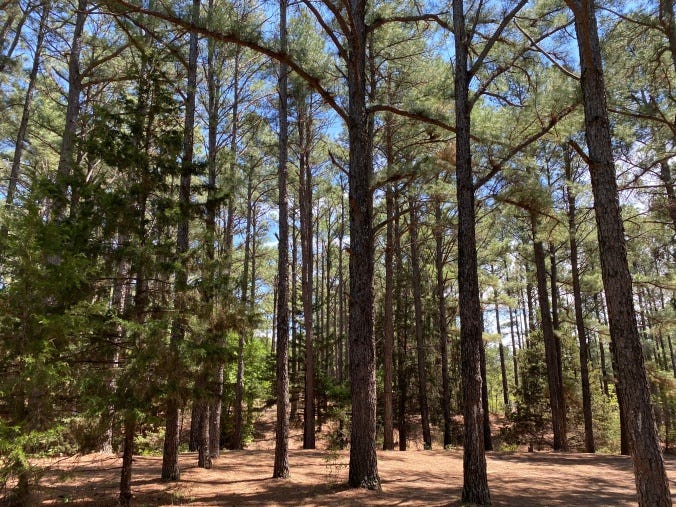(This is a shortened version of something I wrote at Our Lives in Nature. You can read the whole thing over there. I promise to resolve this crazy thing where I’m writing in both places very soon.)
Yesterday I took a couple of friends to visit the LBJ National Grasslands (LBJNG). There was a little light rain as we walked around the pine trees and ponds, seeing a few frogs and toads. We wandered out onto the prairie at sunset, seeing some flowers that are a reminder, for a while, of the spring that has just passed. It’s fun and it is a privilege to introduce people to this place and all the lives that make use of the ponds, woods, and prairies. As one example, Logan caught a Blanchard’s Cricket Frog and we talked a little about how we identify it and how we can briefly hold onto it before letting it go and watching it disappear in long leaps.
Some time ago, Kayla West and I led walks there regularly to introduce people to this amazing place, and we had a Facebook group for a while. I've adapted some of what I wrote during that time, providing it here for those who may not have visited yet, to help you get acquainted and consider taking a walk there. You might also want to subscribe to Mary Curry's blog, "Looking Out in North Texas," in which she describes lots of ramblings in places like the National Grasslands and finding plants, fungi, mosses and lichens, and wildlife.
The LBJNG is located along the eastern edge of the Western Cross Timbers, which is an area where patches of prairie are mixed in with woodland (largely Post Oak and Blackjack Oak). You rarely walk very far in the oak woods without emerging into a little meadow or perhaps a large expanse of grassland. The grasses include Little Bluestem, Indiangrass, Switchgrass, and some other native species, some smaller ones like Sideoats Grama and big ones which, in some patches, stand above your head.
The soil and rock beneath it is largely Antlers Sand with some Walnut and Goodland formation limestone and clay (see "Geology of Wise County, Texas"). These geological features are from the Cretaceous period (roughly 145-65 million years ago). Walking the trails of LBJ National Grasslands, you come into contact with reddish sand and clay, or along ridges in southern units there is limestone filled with fossil oysters.
The grasslands are dotted with many small ponds, and many were created by people with the aim of reducing runoff and soil erosion as well as providing water for cattle. There are also several small lakes constructed for the same purpose as well as providing recreation. Those include Cottonwood Lake (about 40 acres in size), Black Creek Lake (about 30 acres), and Clear Lake (about 20 acres, with a small fishing pier).
In several spots within the grasslands there are areas dominated by Loblolly Pines. They are generally in areas of deep sand with one or more ponds and are popular with campers. Pine trees are not a typical part of the Cross Timbers plant communities, and we have been told by Forest Service staff that pine seedlings were brought to the area 40 or 50 years ago and planted. Today many of the trees have grown quite tall, and smaller trees and seedlings show that these pine groves are well-established and even expanding.
As delightful as the pine trees may be, there is nothing that compares with the prairies and their spring flowers or the native grasses in autumn, or the oak and juniper woodlands on a quiet autumn afternoon.
For the rest of this, including links to maps, ideas for visiting, and tips for keeping the LBJNG and yourself safe, please go to https://livesinnature.com. If you like what you find there, I suggest that you hit the “subscribe” button so that new posts there get emailed to you. You can subscribe for free, or if you can do so there’s an option to make a one-time or recurring donation. If you have donated to support my work here, please just subscribe for free over there.









